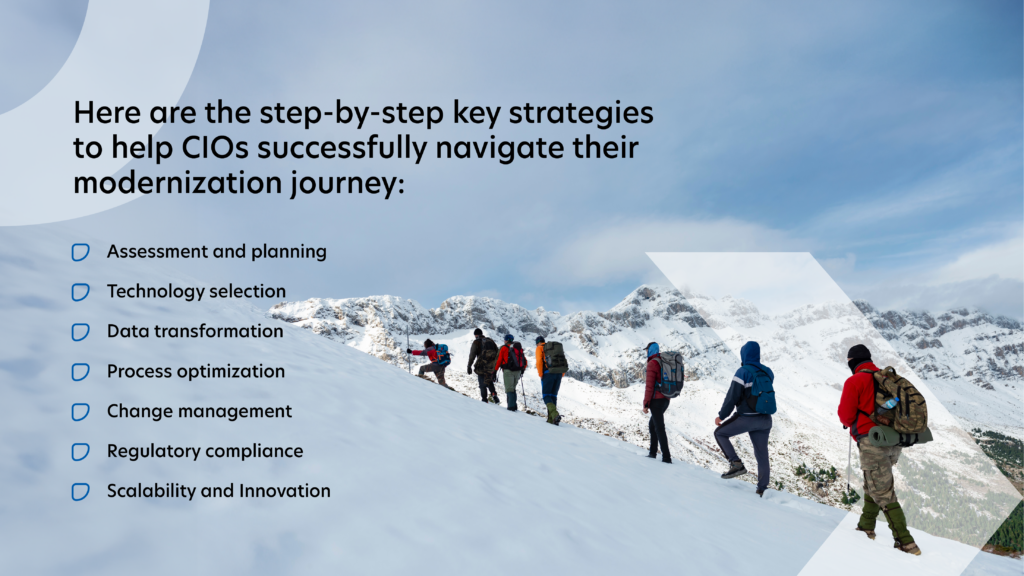From digital marketing to digital distribution and everything in between, it can sometimes seem like the insurance industry has gone all-digital. But if that’s the case, why do CIOs continue to rely on decades-old technology to perform core processes?
The CIOs face a daunting array of challenges that seem to multiply faster than the policies they manage, from the intricacies of risk assessment to the intricacies of legacy systems. A Deloitte Report states that 80% of insurers believe that their legacy systems are a key obstacle to digital transformation.
The insurance world, once steeped in tradition, is now in the midst of a digital renaissance. And CIOs are also tasked with the challenge of steering their companies through an era where disruption is not a question of “if,” but “when.”
Why are Insurers Still Maintaining Legacy Systems
Insurance legacy systems are maintained for several compelling reasons. First and foremost, the insurance industry is known for its complex and heavily regulated environment. Legacy systems, although outdated, have been finely tuned over the years to meet these specific compliance requirements. Replacing them with modern systems can be a daunting and costly task, often involving a high level of risk. Furthermore, legacy systems often store vast amounts of historical data, which is critical for actuarial and risk analysis. Migrating this data to newer platforms without compromising accuracy and integrity is challenging. Additionally, insurers must weigh the potential disruption to their day-to-day operations when considering modernization. Legacy systems have proven their reliability, and making the transition to new technology can introduce unforeseen issues. As a result, insurers are often cautious about when and how to modernize, prioritizing the stability and continuity of their services.

Why should CIOs consider Modernization?
Insurance CIOs should consider adopting legacy system modernization when their existing infrastructure becomes a hindrance rather than an enabler of business growth. Legacy systems, often built on outdated technology, can impede operational efficiency, hinder innovation, and pose security risks. CIOs should prioritize modernization if they face challenges in integrating new digital channels, data analytics, or emerging technologies like blockchain or AI. Moreover, compliance with evolving regulations is critical in the insurance industry, and outdated systems can make this compliance onerous. CIOs must also assess the total cost of ownership – maintaining legacy systems can be expensive, and the funds allocated could be better utilized in modernization efforts. When customers demand real-time services and personalized experiences, legacy systems can no longer suffice. Therefore, it’s imperative for insurance CIOs to embark on modernization journeys to enhance agility, competitiveness, and customer satisfaction, thereby ensuring long-term sustainability in the dynamic insurance landscape.
According to Deloitte report, ‘71% of insurers are in the process of performing modernization’
The Value of Legacy System Modernization
- Enhanced Agility and Adaptability: With legacy systems, updates and changes are often slow and cumbersome. According to Gartner Inc., 91% of CIOs reported that technical debt provoked by legacy programs influences agility and delivery speed. Modernization opens the door to agile development methodologies and microservices architecture, enabling CIOs to respond quickly to market demands and regulatory changes. This agility is crucial in a rapidly evolving industry where customer expectations and regulatory requirements are in constant flux.
- Improved Customer Experience: A seamless customer experience is paramount in the insurance industry. Legacy systems are notorious for their lack of user-friendliness and outdated interfaces. Modernization can transform the customer journey by enabling omnichannel experiences, self-service options, and real-time data accessibility. This, in turn, leads to higher customer satisfaction and retention, which are vital for insurers in a competitive market.
Lemonade, a digital insurance disruptor, provides a seamless and AI-driven customer experience, allowing customers to purchase policies and file claims quickly through its app, reducing customer friction. - Data-Driven Decision-Making: Data is the lifeblood of the insurance industry. McKinsey estimates the insurance industry generates approximately 2.8 zettabytes of data annually. Modernizing legacy systems provides CIOs with the tools to harness the power of data analytics and artificial intelligence. By migrating to modern, cloud-based systems, insurers can access and analyze vast amounts of data in real time. This data-driven approach empowers CIOs to make informed decisions, optimize underwriting, detect fraud, and predict trends with greater accuracy.
Progressive’s Snapshot program utilizes telematics data to offer personalized insurance rates based on driving behavior, demonstrating the power of data-driven decision-making. - Cost Efficiency: Legacy systems often come with high maintenance costs, as they require specialized skills and frequent updates. Modernization can lead to substantial cost savings in the long run. Cloud-based solutions reduce infrastructure costs, while automation and streamlined processes cut down on operational expenses. CIOs can redirect these savings towards innovation and growth initiatives.
Aon, a global insurance broker, saved over $500,000 annually in operational costs by modernizing its legacy systems and moving to cloud-based solutions. - Regulatory Compliance: According to a PwC survey, 62% of insurance CEOs identified regulatory concerns as the most significant threat to their growth prospects. Staying compliant with ever-evolving regulations is a top priority for insurers. Legacy systems are often ill-equipped to adapt to these changes, making compliance a challenging task. Modernized systems can be designed with compliance in mind, incorporating features that facilitate adherence to the latest regulations.
The Modernization Roadmap

Here are the step-by-step key strategies to help CIOs successfully navigate their modernization journey:
- Assessment and Planning
Begin by conducting a comprehensive assessment of your existing systems, processes, and infrastructure. Identify areas that need modernization and prioritize them based on their impact on your organization’s strategic goals. Develop a detailed modernization plan that includes timelines, budgets, and key performance indicators. - Technology Selection
Carefully evaluate modern technologies and solutions available in the market. Choose systems that align with your organization’s long-term vision and offer the scalability and flexibility needed for future growth. Consider cloud-based platforms for agility and cost-efficiency. - Data Transformation
Ensure that your data is clean, integrated, and easily accessible. Implement data analytics tools to extract actionable insights from your data, aiding in decision-making, risk assessment, and customer profiling. - Process Optimization
Review and reengineer your business processes to streamline operations and eliminate redundancy. Automation should be a central focus to improve efficiency, reduce costs, and enhance customer experience. - Change Management
Modernization efforts impact not only systems and processes but also people. Invest in change management to ensure that your staff is well-prepared and motivated for the changes. Effective training and communication are vital. - Regulatory Compliance
Given the stringent regulatory environment in insurance, ensure that your modernized systems are compliant with all applicable regulations. Partner with legal and compliance experts to navigate this complex landscape. - Scalability and Innovation
Modernization is not a one-time project but an ongoing journey. Build systems and processes that can adapt to future market changes. Foster a culture of innovation within your organization to stay ahead in a competitive landscape.
Modernize your Legacy Systems with Quinnox:

The journey from legacy to agility in the insurance industry is both a daunting challenge and an exciting opportunity. As we’ve explored in this comprehensive guide, legacy modernization in insurance brings many benefits. It paves the way for enhanced customer experiences, streamlined operations, and increased competitive advantage in an ever-evolving market.
Yet, it’s important to acknowledge the hurdles that come with legacy system modernization – the intricate web of interconnected processes, the fear of downtime, and the resistance to change. These challenges are real, but with a well-structured roadmap in place, CIOs can navigate these waters effectively and arrive at the shores of modernization success.
Are your legacy systems holding you back in the race to modernization? Quinnox with multiple successful legacy modernization projects, helps you in navigating this transformative path. With the right strategy, the right partner, and a forward-thinking mindset, your legacy systems can become the springboard for a more agile, competitive, and customer-centric insurance operation.
Connect with our Experts Today!